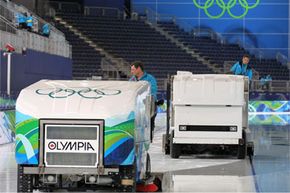Glossing Over History
The history of Zamboni — and ice resurfacers in general — begins in 1940. That was when Frank J. Zamboni, his brother Lawrence and a cousin built and opened an ice rink in Paramount, Calif. (The brothers ran an ice and refrigeration plant, so an ice rink was in their professional wheelhouse.) But when it came to maintenance, the 20,000-square-foot (1,858-square-meter) rink sounded like a nightmare. To resurface the ice, they used a tractor with a blade to scrape the top layer. A crew of people scrambled behind to collect ice shavings and spray the surface with hot water. After waiting for the water to refreeze, the process took a whopping hour and a half, which must've been a considerable chunk of time to usher skaters off the ice [source: Fleming].
Frank J. Zamboni struggled with how to keep the ice clean and kempt and spent the next nine years building a contraption that would let skaters glide prettily. (Or fall smoothly, depending on your skill level.) He spent some serious time creating an almost frightening fusion of a machine. This thing had a Jeep engine, the chassis of an oil derrick and the hydraulic cylinder of a plane among other things. But it worked, and the Model A Zamboni Ice Resurfacer finally did the job right in 1949.
Advertisement
The machine was perfected along the way, but early customers included the Boston Garden, figure skating legend Sonja Henie and the Chicago Blackhawks. In 1960, the Zamboni debuted at the Winter Olympics in Squaw Valley, Calif. (Which surely belongs on a list of Strange Places the Olympics Have Been Held). In 1967, after the hulking machines became so well-known that they were tapped to follow the Ice Capades for a Soviet Union tour, a second factory was put up in Brantford, Ontario.
While the Zamboni brand has about 80 percent of the market share in the U.S., the company does have one issue: The product is too well-made now. Zambonis just don't need to be replaced that often, so there are only about 200 made a year— but don't you cry for them, since in 2010 the company pulls in $20 million in estimated annual sales [source: Fleming].
But before we glide right over it, let's get down to business. How the heck do these massive machines that look like the boxy cousins of a tractor actually do their job?
